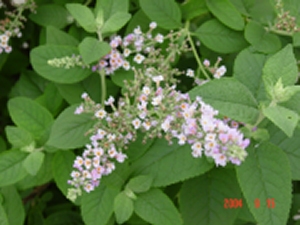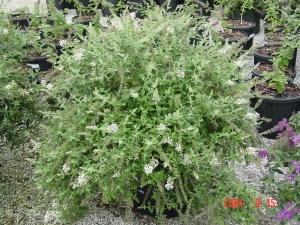 |
 |
 |
 |
 |
 |
 |
 |
 |
 |
 |
 |
|
|
|
Last Update September 13, 2004 |
What's New!
|
New Mite-resistant Buddleias from The University of Georgia and the Center for Applied Nursery Research Michael A. Dirr Unique new Buddleia selections from the University of Georgia and the Center for Applied Nursery Research combine colorful fragrant flowers; semi-evergreen mite-resistant foliage; and more restrained habit than typical B. davidii cultivars. These hybrids are derived from B. ×weyeriana ‘Honeycomb’ × B. lindleyana. One unique seedling from this cross was named ‘Violet Eyes’ and has been evaluated for 5-years. The lustrous dark green foliage is evergreen at 5 to 10EF and mite resistant. In evaluations at the Horticulture Farm, Oconee County, Georgia, ‘Violet Eyes’ showed no mite infestations while all B. davidii types suffered damage. The flowers of ‘Violet Eyes’ are similar to those of B. lindleyana and without fragrance. The outside of the corolla is dusty lavender, the inside violet-purple, hence, the name ‘Violet Eyes’. The original plant is 10 feet high and wide and does not sucker like typical B. lindleyana. The plant was named and given to interested nurserymen but never made it into commerce. The remarkable aspect was the high mite resistance throughout the five-year evaluation period. Since the parentage of ‘Violet Eyes’ commingles B. davidii, B. lindleyana and B. globosa, it is reasonable to expect that second generation seedlings would segregate to resemble parental characteristics. The promise of a mite-resistant, colorful, fragrant, more compact butterfly bush was appealing. So in January 2003, seeds of ‘Violet Eyes’ were germinated and seedlings grown to flowering at the Center for Applied Nursery Research. The highest percentage of seedlings had foliage similar to B. lindleyana with varying degrees of persistence. Seven selections were made with these evaluated for the duration of 2003 and through 2004. They were never sprayed for any insect or disease during the evaluation period. They were not deemed worthy of patent or trademark protection, however, three have floral, foliage and habit characteristics that justify their release to the Georgia Nursery Industry. They will be available through the Center for Applied Nursery Research with the proceeds from liner sales helping to fund Center operations. Several observations about mite resistance are in order. Jeff Gillman (PhD) who worked with me and Dr. Kris Braman on the mite resistance in Buddleia, assessed leaf surface chemistry and trichome (hair) density and configuration. Jeff concluded that although mites were present on B. lindleyana, they could not effectively feed on the lower leaf surfaces because of the matted-woven pubescence that served as a physical barrier. Microscopic examinations of the lower leaf surfaces reveal a woven fabric composition. This unique pubescence is evident in the 3 selections described herein. These selections hold up better in containers and do not suffer the aesthetic decline common on B. davidii cultivars. The flowers are not as large and showy as the B. davidii types but are produced in great profusion. Their ultimate landscape sizes are unknown but I estimate 5 to 8 feet. The foliage is evergreen to semi-evergreen in zone 7 and above. Since plants flower on new growth, stem injury in winter does not preclude flowers the following year. Plants have flowered from May-June to October in Dearing, Georgia. Interesting also that ‘Violet Eyes’ flowers have NO fragrance. All the selections have low to medium fragrances that do not measure up to the best B. davidii cultivars. I theorize that seedlings from these selections will have larger inflorescences, brighter colors and increased fragrances. Buddleia is easily flowered from seed in a single growing season, providing ‘instant’ feedback to support/refute the above suppositions. Royal Horticultural Society color designations are also listed since the description of flower colors is difficult. Violet Eyes-01-03 HABIT: Compact, rounded, 26 inches tall, 27 inches wide in
7-gallon container |
|
|
FLOWER: Inflorescence: 4.7 inches long Bud Color: Purple (RHS - Violet Group 84A) Petal (lobes) Color: Lavender (RHS - Purple Group 76A) Throat Color: Orange (RHS - Yellow-Orange Group 23A) Corolla Tube: Orangish (RHS - Red-Purple Group 73B) Fragrance: Low |
 |
|
Violet Eyes-02-03 HABIT: Compact, mounded to wide-spreading, 16 inches tall, 24 inches wide in 7-gallon container
|
|
|
FLOWER: Inflorescence: 6.1 inches long Bud Color: Purple (RHS - Violet Group 83A) Petal (lobes) Color: Raspberry purple (RHS - Purple-Violet Group N81A) Throat Color: Orange (RHS - Yellow-Orange Group 23A) Corolla Tube: Reddish-purple (RHS - Purple Group N78A) Fragrance: Medium |
|
|
Violet Eyes-03-03 HABIT: Compact, rounded, 21 inches tall, 24 inches wide in 7-gallon container
|
|
|
FLOWER: Inflorescence: 4.5 inches long Bud Color: White (RHS - White Group 155D) Petal (lobes) Color: Pure white (RHS - White Group 155B) Throat Color: Yellow (RHS - Yellow-Orange Group 16A) Corolla Tube: Cream-yellow (RHS - White Group 155D) Fragrance: Low |
 |
|
FOLIAGE: Size: 2.3 inches long × 0.88 inches wide Color: Light to medium green above (RHS - Green Group 137B); gray below (RHS - Greyed-Green Group 191B) Pubescence: Woolly, matted, woven-textured
For a limited time, CANR will be providing start up liners of the new Buddleia "Eye" series. To order liners, either phone (706-597-8309), fax (706-595-1546) or email your order to canr@classicsouth.net. Limited quantities available now, more next spring. We are asking for a minimum of 100 per variety; call for exceptions. Click here for order form. |
|